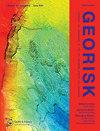Time capsule for geotechnical risk and reliability
IF 6.5
3区 工程技术
Q1 ENGINEERING, GEOLOGICAL
Georisk-Assessment and Management of Risk for Engineered Systems and Geohazards
Pub Date : 2022-11-07
DOI:10.1080/17499518.2022.2136717
引用次数: 11
Abstract
ABSTRACT This paper is motivated by the Time Capsule Project (TCP) of the International Society for Soil Mechanics and Geotechnical Engineering (ISSMGE). The historical developments of geotechnical risk and reliability are reviewed for the past six decades. The key features distinguishing geotechnical and structural engineering are the natural origin of the ground and the lack of sufficient data to characterize the ground using the more familiar frequentist interpretation of probability. For the first feature, random field theory is applied to model spatial variability and the random finite element method or other methods are proposed for solving soil-structure interaction problems in spatially variable soil. For the second feature, compilation of databases is essential to serve as priors for Bayesian updating and more recently for Bayesian machine learning. There is a gradual evolution towards reliability-based design because probabilistic methods offer a pathway to address big data and implement data-centric geotechnics as one step towards digital transformation. Given the complexity of the natural ground (known unknowns can be large and there are unknown unknowns), engineering judgment remains important to bridge the gap between theory and practice. However, the role of engineering judgment needs to be updated as modern machine learning methods become more powerful.岩土工程风险和可靠性的时间胶囊
摘要本文由国际土壤力学与岩土工程学会(ISSMGE)的时间胶囊项目(TCP)发起。回顾了过去60年来岩土工程风险和可靠性的历史发展。岩土工程和结构工程的主要特征是地面的自然起源,以及缺乏足够的数据来使用更熟悉的频率论概率解释来表征地面。针对第一个特点,将随机场论应用于空间变异性模型,并提出了随机有限元法或其他方法来解决空间变异土壤中的土-结构相互作用问题。对于第二个特征,数据库的编译对于作为贝叶斯更新的先验以及最近的贝叶斯机器学习的先验是至关重要的。由于概率方法提供了一条解决大数据问题的途径,并将以数据为中心的岩土工程技术作为数字化转型的一步,因此逐渐向基于可靠性的设计发展。考虑到自然地基的复杂性(已知的未知因素可能很大,也有未知的未知因素),工程判断对于弥合理论和实践之间的差距仍然很重要。然而,随着现代机器学习方法变得更加强大,工程判断的作用需要更新。
本文章由计算机程序翻译,如有差异,请以英文原文为准。
求助全文
约1分钟内获得全文
求助全文
来源期刊
CiteScore
8.70
自引率
10.40%
发文量
31
期刊介绍:
Georisk covers many diversified but interlinked areas of active research and practice, such as geohazards (earthquakes, landslides, avalanches, rockfalls, tsunamis, etc.), safety of engineered systems (dams, buildings, offshore structures, lifelines, etc.), environmental risk, seismic risk, reliability-based design and code calibration, geostatistics, decision analyses, structural reliability, maintenance and life cycle performance, risk and vulnerability, hazard mapping, loss assessment (economic, social, environmental, etc.), GIS databases, remote sensing, and many other related disciplines. The underlying theme is that uncertainties associated with geomaterials (soils, rocks), geologic processes, and possible subsequent treatments, are usually large and complex and these uncertainties play an indispensable role in the risk assessment and management of engineered and natural systems. Significant theoretical and practical challenges remain on quantifying these uncertainties and developing defensible risk management methodologies that are acceptable to decision makers and stakeholders. Many opportunities to leverage on the rapid advancement in Bayesian analysis, machine learning, artificial intelligence, and other data-driven methods also exist, which can greatly enhance our decision-making abilities. The basic goal of this international peer-reviewed journal is to provide a multi-disciplinary scientific forum for cross fertilization of ideas between interested parties working on various aspects of georisk to advance the state-of-the-art and the state-of-the-practice.

 求助内容:
求助内容: 应助结果提醒方式:
应助结果提醒方式:


